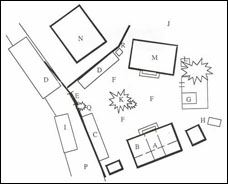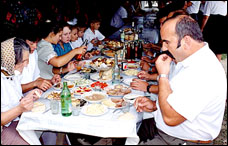
Toporivtsi Wedding Photo Gallery
The Pre-Wedding Phase
The Wedding Day
The Description of wedding traditions in Ukraine from the previous section is generalized to represent the typical activities in the 19th century. Many variations existed and continue to exist today. The following description of a 1995 wedding in Toporivts provides a rich concrete example.
Registering at the ZAHS
The couple went to the ZAHS [Zal aktiv hromadians'koho stanu, Hall of
ceremonies related to civil status] for the legal ceremony of registering of
their marriage on the Thursday prior to the wedding, partially to free time in
the Saturday and Sunday schedule. In the Soviet period, church authorities were
not authorized to register weddings legally, but that function was taken over
by this secular institution. In the post-Soviet period, couples often register
at the ZAHS and have a public church marriage as well.
Preparations
In the week preceding the wedding, a refrigerated truck trailer was parked
outside the bride's parents' yard to store and preserve food for the wedding.
The yard was cleaned thoroughly. A raised and covered platform was built over
the root cellar for the musicians, and long tables under shed roofs and tents
were assembled around the edges of the yard. An additional eating area and tent
roof was assembled on the roadway in front of the yard. The bride's girlfriends
spent a week making decorations of intricately cut paper to adorn the tents and
tables at which the guests would eat.
Before the wedding, vegetables were harvested, animals were slaughtered, and a
great deal of food was purchased for the meals. Sausages and other meats were
smoked. A large quantity of alcohol had been distilled through the season prior
to the wedding. Many local women prepared the food, coordinated by a specialist
in the community known for her skill and experience as a wedding cook. Similar
preparations were being made at the groom's family's house about a kilometre
and a half away.
The events of Saturday were known as "Svatannio". On Saturday morning, six or seven teenagers, school friends of the bride, set
up the vinok, a decorated archway above the gate into the yard. It was made of
wire bent in a large arch, covered with greenery. A baby doll was attached to
the top of the archway in reference to the future children of the couple, and
an electric light bulb was installed to illuminate the events that would take
place there at night. The following is the layout of the bride's yard for the
wedding
 A
= main house A
= main house
B = room used for dressing bride
C = main table under temporary roof
D = additional tables under temporary roofs
E = vinok and gate into yard
F = dance area
G = temporary covered stage built for band above dugout cellar
H = food preparation area
I = refrigeration trailer parked
J = garden, K = apple tree in centre of dance area
L = outhouse, M = summer kitchen,
N = neighbour's house
P = road, Q = barvinok growing,
R = well
Making the bride's headpiece
At approximately 11:00 am on Saturday morning, the bride sat on a pillow on a
chair in the front room of their house and her grandmother and mother began
combing and braiding her hair. Three bridesmaids, dressed in local traditional
clothes, sang a song specific to this ceremony. Her mother cried as she combed
out her hair. The bride's grandmother took a needle and thread and sewed a
round ring, approximately 8 centimetres in diameter and 6 centimetres tall,
firmly onto her hair at the top of her head. A decorative outer ring was later
placed over this base, and a tall grass headpiece called a koda was fitted
snugly into the ring. The bride, also in traditional clothing, continually
checked in the mirror to see if her headpiece was being put on to be as
attractive as possible. The bridesmaids continued to sing for each stage in
this process.
video 1: Making the bride's headpiece (grandmother's work) (17.5mb)
video 2: Making the bride's headpiece (mother/pillow/koda) (4.2mb)
 Rus'ka
dance Rus'ka
dance
Dressed in their svatannia clothes, the bride and her brother walked out of the
house into the yard. He called on the musicians to play a rus'ka dance, and the
bridesmaids, bride and brother danced the first dance of the wedding.
video 3: Rus'ka dance (18.3mb)
A ceremony picking the periwinkle and wreath-weaving
Guests gradually started arriving at the bride's home for the wedding
celebration. Approximately 2:00 in the afternoon, the bride and her family
performed a ceremony picking the periwinkle [barvinok] for her wedding wreath.
The plant was growing near a tree in a corner of the yard. Her mother sprinkled
the plant with water and salt, then prepared a few strands to be plucked by the
bride through the hole in the centre of a doughnut shaped wedding bread. The
bride did not contact the plant directly, but touched it only through a
handkerchief. The musicians, meanwhile, played a specific melancholy [zhalobna]
ritual melody. The bride plucked the periwinkle three times in this manner.
Later, the periwinkle was carried into the house, where it was woven into a
wreath for the wedding ceremony.
At 9:00 p.m. at the groom's house, the groom and his immediate family picked
periwinkle from their flowerbed in a procedure very similar to the bride's
ceremony in the afternoon.
video 4: Picking the periwinkle (8.6mb)
Toasts
Just after the ceremony picking the periwinkle, the bride's father raised a
small glass of vodka to his daughter, asking forgiveness for his shortcomings
as a father and wishing her well on her new journeys in life. He drank, the
glass was refilled, and the bride toasted him in return. She asked for his
forgiveness for the trouble she caused as a child, for her misbehaviour and any
other failings, and thanked him for the many good things he had done, providing
for her as she grew up. She promised to continue trying to be a good daughter
as a married woman. She and her father wiped tears from their eyes. The bride
then repeated this exchange of toasts with her mother, both now crying freely.
The bride and her brother next exchanged a similar toast, forgiving each other
and wishing well for the future. Other members of the extended family joined in
on the exchange of toasts.
The groom and his family exchanged toasts and blessing in the same manner after
he picked the periwinkle as well.
video 5: Toasts (10.5mb)
 The
pre-wedding party The
pre-wedding party
The guests continued to arrive at the bride's house, and danced all afternoon
and evening. Dances included "shake" ¹ (modern social dancing in a circle),
"rus'ka" ["the Ruthenian one"], the polka, waltz and others. Several hundred
guests were served a meal in the evening.
The groom's side also had a pre-wedding party. Guests arrived gradually
throughout the afternoon, including a group of some 35 women designated as
"svashky" wearing traditional clothing. The svashky danced a special version of
the rus'ka dance at about 8:00 in the evening, holding hands and circling
around the groom and the male guests.
The musicians
Musicians were hired for both the bride's and the groom's house. On Saturday
morning, the musicians hired by the bride's side had arrived from their homes
three villages away, and were setting up their instruments, checking
amplification, and playing occasional songs. The band at the bride's home was
typical in that it specialized in playing contemporary popular music. They
played a variety of instruments, usually featuring electric guitars, a keyboard
and a drum set.
Throughout the day, a different group of musicians played at the groom's house.
As was traditional, the groom's band was a brass band. These instruments were
quite loud and did not need amplification. Their portability was an asset since
they were required to travel with the groom to the home of the "wedding father"
on Saturday night and also to play for several hours at the bride's home on
Sunday.
Visiting the "wedding father" and the "wedding mother"
The groom and his svashky and a number of guests left his house about 11:00 on
Saturday night and walked about two kilometres through the village streets to
the home of the "wedding father" and "wedding mother." The bride and her
entourage also made the trip, meeting the groom's party somewhere along the
route and arriving together. Totaling between 75 and 100 people, the parties
sang and danced loudly along the way in the light rain. Upon arriving, the
group was invited inside, welcomed ceremoniously, and hosted to a sumptuous,
exotic "snack" and drinks. They served an unusual green liquor to their guests,
followed by juice and orange pop. The food included decoratively cut fruits
including expensive and rare pineapples as well as marangue, torts and other
pastries of many kinds. Only some 20 or so fit into the room with the large
overloaded table, participating in the more formal toasts and well-wishing at
the beginning of the visit. Other people entered the house to taste the various
delicacies when they found room to squeeze in. The musicians played outside in
the yard, while the hosts and guests danced a rus'ka in a large circle. After
approximately 45 minutes, the revellers left the home of the "wedding parents"
and returned, singing, together to the home of the bride.
video 6: Visiting the "wedding father" and "wedding mother" (6.6mb)
The presentation of gifts
The groom remained at the bride's home for several hours, mostly sitting behind
a table in the house with a group of his groomsmen. The remainder of the guests
danced and ate. Gifts were presented to the bride and groom, and they were
toasted frequently. At about 2:00 a.m., the groomsmen began a dance with a
decorated traditional woven shoulder bag [taistra] in front of the bride and
her brother. The bag was filled with gifts for her, including articles of
clothing, perfume and other items. The bag was not presented to the bride, but
she and her brother had to "steal" it from the dancers. They succeeded after
several tries. The bride also had a taistra filled with gifts for the groom.
She and her bridesmaids danced with it in front of his table, and he was
similarly supposed to steal it from them.
The end of the pre-wedding party
Music continued until approximately 3:30 a.m., when the groom returned home.
After this time, many of the bride's family's guests stayed at the tables,
eating, drinking, talking and singing a while. Several people stayed in the
yard overnight, guarding the tents, food and equipment.
|




